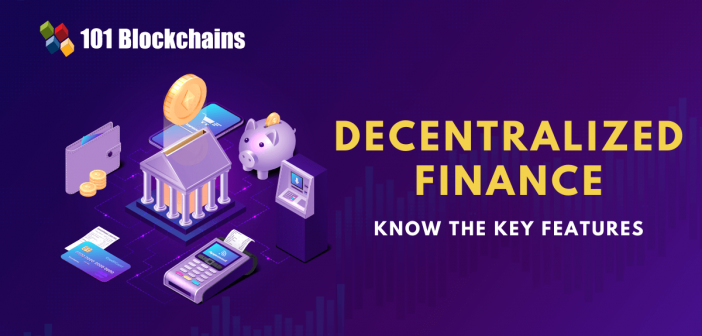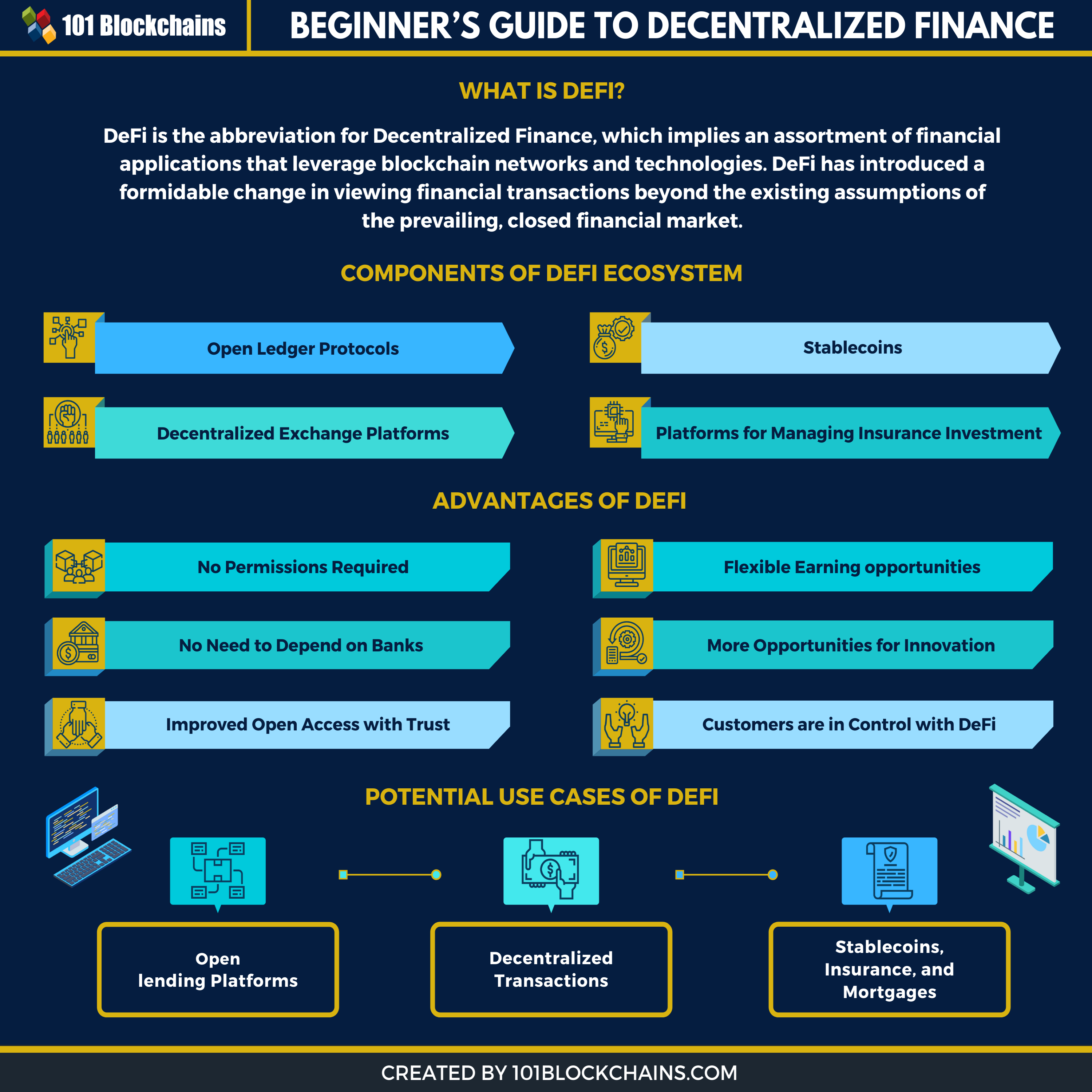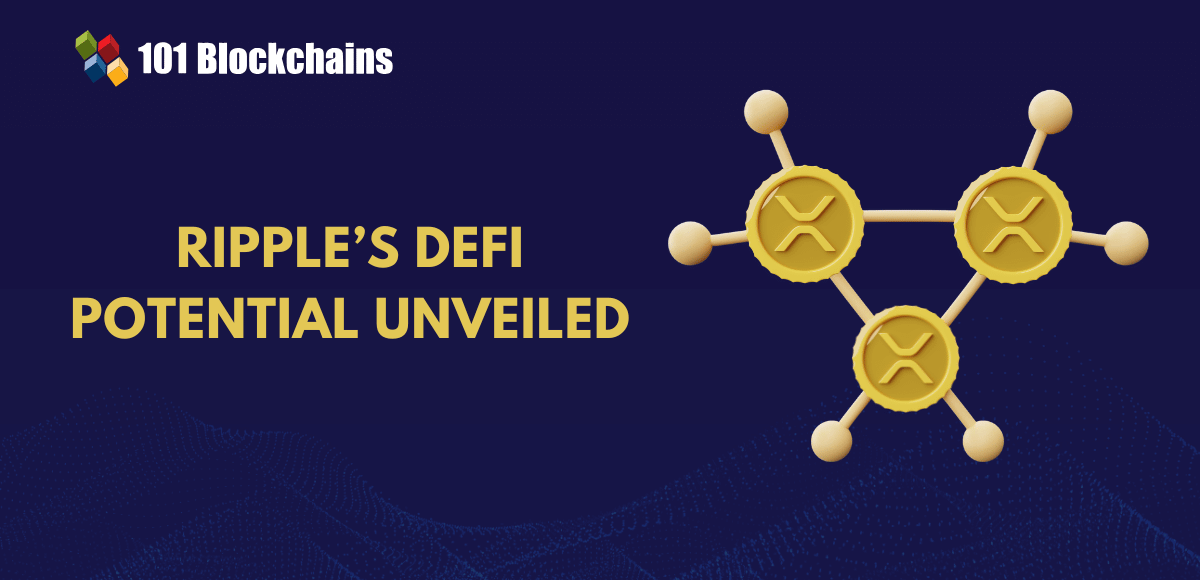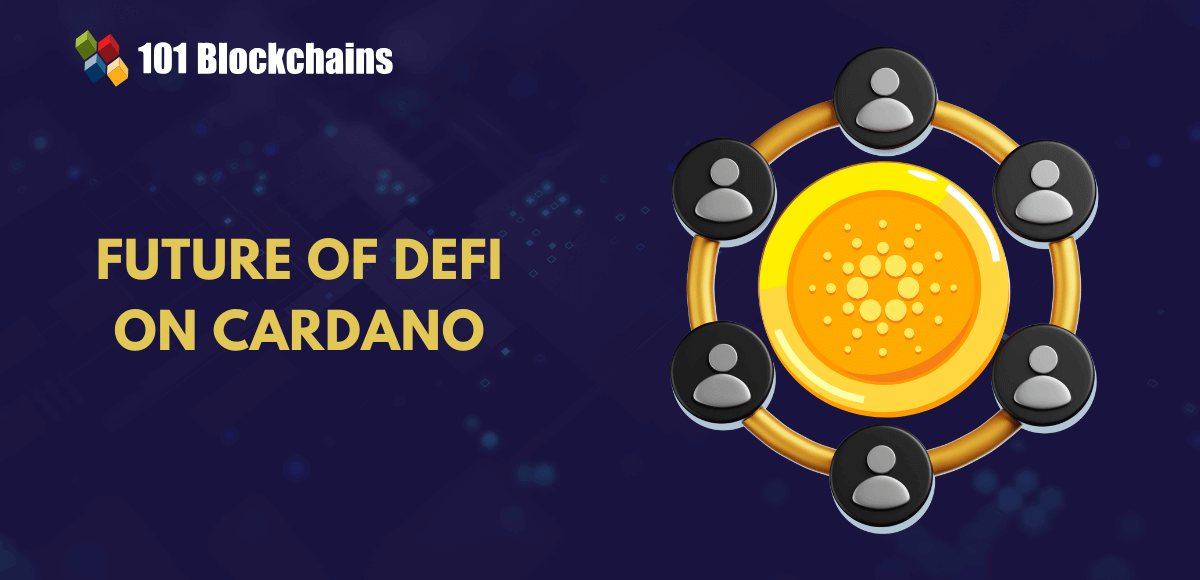Learn how blockchain truly works, master key definitions, and uncover what makes smart contracts so "smart." Dive into the fundamentals, gain valuable insights, and start your blockchain journey today!

- Decentralized Finance
Gwyneth Iredale
- on July 20, 2021
Key Features of Decentralized Finance (DeFi)
Aspiring to learn about the key features of Decentralized Finance? Here we have covered the DeFi features in detail!
The applications of technology in the domain of financial services are not new in today’s world. Many transactions at banks as well as other financial service institutions are carried out with the help of technology. On the other hand, technology has always played the role of support in facilitating such transactions.
Decentralized Finance (DeFi) has changed the conventional notions regarding finance by bringing the best of cryptocurrency foundations and blockchain technology for the management of financial transactions. Therefore, the attention on DeFi features has increased profoundly in recent times.
People are eager to know how DeFi aims at the democratization of finance through the replacement of legacy, centralized institutions with peer-to-peer relationships offering a broad spectrum of financial services. How would DeFi enable the democratization of access to financial services? The following discussion helps you find out the features that would help DeFi transform the face of finance as we know it.
Want to know more about DeFi? Enroll Now: Introduction to DeFi Course
Understanding the Definition of DeFi

Please include attribution to 101blockchains.com with this graphic. <a href='https://101blockchains.com/wp-content/uploads/2020/10/what-is-defi-infographic-1536x1536.png' alt='what is defi' border='0' /> </a>
The first and most important requirement for finding out features of decentralized finance is the definition of DeFi itself. Decentralized finance, or DeFi, points out the transition towards peer-to-peer finance systems from conventional, centralized financial systems. DeFi follows the power of decentralized technologies developed on the Ethereum blockchain.
The DeFi ecosystem features a massive network of financial instruments and integrated protocols with different use cases. As of now, more than $13 billion has been already locked in Ethereum-based smart contracts, thereby opening up new prospects for decentralized finance.
The fundamental details about DeFi from its definition can give you an idea of its basic objective. However, it is difficult to find out more about its working without reflecting on its features. So, let us take a look at some of the notable features of DeFi by delineating its components.
Want to explore in-depth about DeFi protocol and its use cases? Enroll in Decentralized Finance (Defi) Course- Intermediate Level Now!
Components in DeFi
The first and essential aspect for understanding the characteristics of DeFi largely points out to an understanding of its components. The components in DeFi are basically the same as the ones you find in other financial ecosystems existing right now. DeFi components could be stablecoins and services such as lending services and crypto exchanges.
Smart contracts deliver the framework needed for working on DeFi apps. The components of a DeFi system are important features of DeFi. Each component has a specific function in developing the DeFi system and is an essential feature in DeFi. Here are the four important layers which make up the DeFi stack and are crucial for the popularity of DeFi.
-
Settlement Layer
The settlement layer is one of the notable DeFi features as it is the basic layer on which other DeFi solutions are developed. It includes a public blockchain along with the native digital currency. The transactions on DeFi apps generally use the native digital currency, which could be or could not be traded in different markets.
-
Protocol Layer
Software protocols are basically rules and standards tailored for the governance of specific activities or tasks. The protocol layer features a collection of principles and rules which all the participants in a particular industry must follow. DeFi protocols enable interoperability, thereby opening up the scope for use by multiple entities simultaneously for the development of a service or app. The protocol layer is essential for obtaining the desired liquidity levels in the DeFi ecosystem.
-
Application Layer
The application layer is one of the notable features in DeFi, which answers the question of ‘Why is DeFi so popular?’ effortlessly. According to the name, one can clearly infer that the application layer houses consumer-facing applications. The decentralized applications represent the underlying protocols in abstract forms as basic consumer-oriented services. Many applications on the crypto landscape, such as lending services and decentralized exchanges, are found on this layer.
-
Aggregation Layer
The final layer in the DeFi tech stack is also one of the top features of decentralized finance. The aggregation layer includes aggregators connecting different applications from the previous layer for providing service to investors. For example, aggregators could help with the seamless circulation of money among various financial instruments for improving returns.
Want to explore an in-depth understanding of security threats in DeFi projects? Enroll in DeFi Security Fundamentals Course Now!
Key Features of Decentralized Finance
It is also possible to get a clear impression of the characteristics of DeFi by reflecting on the benefits they offer. The benefits actually showcase the value proposition offered by DeFi or the features which you can include in your DeFi solutions. Here are some of the notable features you could find with DeFi.
-
Permissionless
One of the foremost features of DeFi which grab attention is the permissionless nature of DeFi applications. DeFi does not follow the conventional principles of access followed in traditional finance. On the contrary, it follows the open, permissionless access model. Any individual could access DeFi solutions through an internet connection and a crypto wallet. With these two essentials, you could leverage DeFi irrespective of the geography or amount of funds. As a result, DeFi could welcome almost any individual to the financial system.
-
Programmability
Another notable entry among features of decentralized finance is programmability. It is essential to note that majority of the DeFi solutions available now are based on the Ethereum blockchain. Therefore, the opportunity for accessing smart contracts with higher chances of programmability in DeFi could help in automatic execution. At the same time, the programmability in DeFi also opens up new avenues for creating new financial instruments and digital assets. Therefore, DeFi has all the necessary support required for addressing any type of conventional financial service function.
Build your identity as a certified blockchain expert with 101 Blockchains’ Blockchain Certifications designed to provide enhanced career prospects.
-
Transparency
One of the most striking and obvious DeFi features would pay attention to transparency. Every transaction has to be broadcast to other users on the network in the case of the public Ethereum blockchain. All the users should verify the transaction broadcasted to them. It is important to note that all the Ethereum addresses are basically encrypted keys accompanied with pseudo-anonymity.
The enhanced transparency regarding transaction data enables comprehensive data analysis. At the same time, transparency also ensures the availability of information about network activity to any user. Ethereum and DeFi protocols based on Ethereum are also tailored with open source code which is easily available for any user so that they could view, audit, and develop on the existing code.
-
Immutability
The concept of financial inclusion for everyone is one of the promising responses for ‘why is DeFi so popular?’ albeit with concerns regarding immutability. The exchange of information and financial transactions in DeFi requires the assurance of data integrity. So, it is important to have tamper-proof data coordination throughout the decentralized architecture of blockchain.
As a result, it can contribute profound improvements in security and scope for audits. Immutability is not only an essential feature but also a credible value advantage of introducing blockchain in the world of finance. With the assurance of safe and secure data transmission without any unauthorized modifications, DeFi could offer the assurance of integrity for all transactions.
Want to understand the best ways to use DeFi development tools like Solidity, React, and Hardhat? Enroll now in DeFi Development Course!
-
Interoperability
The characteristics of DeFi also take the discussion towards interoperability as one of the prime requirements in the financial services ecosystem today. The composable software stack of Ethereum helps in ensuring that DeFi protocols and applications are tailored for integrating with each other and complementing one another. DeFi gives adequate flexibility to developers and product teams.
Now, developers could easily create new solutions or add functionalities on top of existing protocols. At the same time, developers and product teams could also leverage the traits of DeFi for customization of the interfaces and integration of third-party applications. As a matter of fact, interoperability is one of the reasons for which DeFi protocols are referred to as legos. Just like Lego blocks, you have to find the right way to fit two DeFi protocols together for specific use cases.
-
Non Custodial
The final and most important trait of DeFi refers to the fact that users keep complete control over their assets and personal data. The use of web3 wallets such as Metamask helps users in effective interaction with permissionless financial protocols and applications. With better control over your personal data, DeFi solutions can foster a new age of financial services tailored for the customer.
The different DeFi features are quite crucial entries in almost all discussions related to the origins and growth of decentralized finance. The different features of DeFi protocols make them suitable for various DeFi use cases such as,
- Asset management
- Decentralized Autonomous Organizations (DAOs)
- Lending and borrowing
- Gaming
- Insurance
- Decentralized exchanges
- Data and analytics
- Margin trading
- Staking
- Tokenization
Catch up on the latest trends in decentralized finance (DeFi) and its connection to crypto with comprehensive courses and webinars through DeFi Skill Paths
Bottom Line
On a final note, it is clearly evident that features of decentralized finance bring the ideal mix of cryptocurrency and blockchain features. The different features of DeFi showcase the adequate potential for driving in more users in the future.
For example, the transparency factor allows users to develop trust in financial services, while decentralization ensures that they are not vulnerable to large-scale hacks. At the same time, immutability in DeFi protocols also ensures that sensitive financial information does not fall into the wrong hands. If you want to learn more about the value of DeFi, start exploring more about it with the DeFi course.
*Disclaimer: The article should not be taken as, and is not intended to provide any investment advice. Claims made in this article do not constitute investment advice and should not be taken as such. 101 Blockchains shall not be responsible for any loss sustained by any person who relies on this article. Do your own research!



![30+ Best Decentralized Finance Applications [Updated] best decentralized finance (DeFi) applications](https://101blockchains.com/wp-content/uploads/2020/10/decentralized-finance-applications.png)

